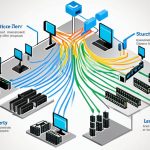Today, digital processes are key for many organizations. It’s vital to have a secure network that can handle lots of data and protect against cyber threats. Tech leaders and their teams can use key strategies to design and keep a secure network architecture.
First, it’s important to know what’s on your network. By listing all devices and how they’re set up, you can spot weak spots. This helps you fix them before they’re a problem1.
Getting input from those in charge is also crucial. It makes sure the network design meets the company’s goals. They can share what the organization really needs, helping shape the network design2.
It’s key to use the principle of least privilege for security. This means giving users only what they need to do their jobs. It lowers the chance of a security issue and keeps unauthorized access out3.
Using a zero-trust model is another smart move. It questions the old way of thinking by assuming nothing is safe. With strong checks, strict access rules, and constant watching, you can fight off threats from inside and out3.
Following the “defense in depth” idea means using many security steps to protect your network. Combining things like firewalls, systems that detect intrusions, and encryption makes a strong defense. Even if one thing fails, others can still protect you1.
Segmenting your network is also vital. It limits how far an attacker can go if they get in. This stops threats from spreading and reduces damage13.
Adding encryption and VLANs boosts security even more. Encryption keeps data safe as it travels over the network. VLANs help organize devices into groups, making it harder for unauthorized access13.
Key Takeaways
- Inventory and document network assets to identify vulnerabilities and mitigate risks.
- Seek input from decision makers to align security requirements with business goals.
- Implement the principle of least privilege to minimize the impact of security breaches.
- Adopt a zero-trust model to challenge traditional perimeter-based security.
- Follow the “defense in depth” principle by implementing multiple layers of security controls.
Inventory and Diagram All Network Assets
Designing a secure and efficient network starts with a key step: inventorying and diagramming all network assets. This gives a full view of the network’s parts and helps understand its setup and how it works. By mapping out the network assets and making a mapping diagram, companies get deep insights into their network. They can also see their future goals and needs.
Having an accurate inventory means no network asset is missed. From servers and routers to switches and firewalls, each piece must be listed. This helps understand the network’s strengths and weaknesses. It also shows which equipment is old or extra, helping to upgrade for better performance and security.
Using data from the link4, we see key strategies for a secure network. These include the least privilege rule, a zero-trust model, and network segmentation. These match the process of listing and mapping network assets. By sorting assets by their role, place, and security needs, companies can use segmentation well. This limits access and lowers the risk of breaches.
Having a full inventory helps companies focus on what’s most important. For example, applying automatic encryption to key assets keeps the network safe without wasting resources.
Looking at the data from the link5, we see why inventory and mapping matter. A growing company might face network issues during busy times, making users unhappy and less productive. Regular updates to the network asset list help spot and fix bandwidth problems early. This keeps operations smooth and users happy.
An inventory helps in making network configurations decisions. Choosing between IPv4 and IPv6, or static or dynamic IP, depends on the network’s size and growth plans. A detailed inventory helps companies make smart choices that fit their needs and future growth, as the link5 shows.
In summary, inventorying and diagramming network assets is crucial for a secure and efficient network. It helps spot weaknesses, set up network segments, and fine-tune security settings. This careful planning keeps the network safe, efficient, and ready for growth and updates.
Seek Input From Decision Makers
To design a secure and efficient network architecture, it’s key to get input from business leaders6. This way, network architects get insights into what the company aims to achieve6. This ensures the network supports the company’s goals and strategy6.
Knowing the business goals is vital for using software-defined segmentation6. This method lets network teams divide the network into secure segments based on what’s needed6. It’s cheaper, easier to scale, and more flexible than old methods6.
When leaders are part of the design, the network gets a strategy that fits the company’s unique needs6. They help pinpoint what needs extra security and make sure it gets it6.
Also, getting leaders involved boosts the focus on network security6. It spreads a culture of cybersecurity awareness and makes sure security is part of the network from the start6.
Benefits of Seeking Input From Decision Makers
“Inviting decision makers to help design the network architecture builds a sense of ownership and responsibility for cybersecurity. This leads to better implementation and more support from everyone.”6
Working with leaders helps tie technical choices to business goals6. They provide insights on the business’s challenges and needs, helping architects design a network that’s both secure and productive6.
By including leaders in the design, security becomes a top priority across the organization6. This approach boosts the ability to protect data, systems, and against cyber threats7. It also builds a strong security culture, where cybersecurity is part of everything the business does7.
When getting advice from leaders, knowing the company’s goals and needs is crucial6. This helps architects design a secure network that meets the company’s strategic aims and follows best practices6.
Involving leaders in designing the network makes cybersecurity a key part of the business strategy6. It leads to using software-defined segmentation6, which is cost-effective and scalable for network security6. This teamwork between tech and business teams creates a secure network that matches the company’s goals6.
Implement Least Privilege
It’s key to use the principle of least privilege in your network design. This means giving users and systems only what they need to do their jobs. This way, if there’s a security issue, it’s less likely to spread across the network8.
This approach also makes sure users can only see and use what they need for their job. This lowers the chance of data theft and wrong actions8.
For years, the idea of least privilege has been a big deal in computer security. It’s all about giving users the least access they need to do their jobs. This helps protect against security risks8.
People with lots of access, like system admins, are key to keeping things running right. But, they’re also a big risk if someone hacks their account8.
Over time, people can get more access than they need, which is bad for security. This goes against the idea of least privilege8. But, using least privilege makes it harder for hackers to get into your system and cause trouble8.
Using least privilege also makes your system run better. It cuts down on unnecessary system interactions and stops mistakes from happening. This makes your system more stable8.
In cloud computing, having users with too much access is a big risk. That’s why following the principle of least privilege is more important than ever to keep data safe8.
To follow this principle, you can check on who has special access, take away access you don’t need, and keep different kinds of accounts separate. Change passwords often and keep an eye on cloud permissions8. It’s important to check and manage who has access and take away access when you don’t need it anymore. Using tools to help manage access rights is also key to keeping your system safe8.
Adopt a Zero-Trust Model
A zero-trust model is a strong way to keep networks safe. It focuses on user and device verification, segmentation, and access controls. This approach helps fight new threats and gives companies a solid security plan.
With a zero-trust model, every user and device must be checked before they can get into network areas. This user and device verification makes sure only the right people and devices can see important stuff. This lowers the chance of someone getting in without permission.
Segmentation is key in a zero-trust model. It breaks the network into smaller parts, each with its own rules for who can get in. This stops bad stuff from spreading and helps manage traffic better.
Access controls are very important in a zero-trust model. They make sure people only get to see what they need to see. This cuts down the risk of a security issue getting worse. Tools like IAM, MFA, RBAC, and ABAC help control who gets in.
A survey by Fortinet found 84% of companies use a zero-trust strategy9. The OMB wants agencies to use zero-trust by 20249. The CISA Zero Trust Maturity Model shows how important identity, devices, and data are for security9.
Using a zero-trust model helps protect against unauthorized access and data breaches. It keeps customers’ trust and saves money by focusing on protecting their data10. Tools like UEM and EDR make this model even stronger10. Microsegmentation and least-privilege access add more security layers10.
Zero trust network access (ZTNA) checks users and devices before they can use applications. This makes sure access is secure, no matter where users are10. More companies are using ZTNA for secure access everywhere10.
A zero-trust model looks at many things like identities, devices, and data. It checks things like user role, location, and device status. It uses analytics for real-time threat protection and filters traffic for safety11.
By using a zero-trust model, companies get better security, fight new threats, and protect important data. This approach follows the latest security standards, offering a strong way to keep digital info safe.
Follow ‘Defense In Depth’ Principles
Securing your network means using defense in depth. This means having many security layers to protect against cyber threats12. By using advanced security tools and practices, you can keep your important data safe from cyber threats.
Defense in depth says one security measure isn’t enough. It’s about having many security layers. Each one protects in its own way, making it harder for hackers to get through13. This way, if one security layer fails, others can still protect your network.
This strategy goes beyond just network security. It covers all systems and apps from start to finish13. It uses physical, technical, and administrative controls to protect everything14. For example, surveillance and access control systems help keep unauthorized people out13.
Network security tools like firewalls and VPNs keep network traffic safe13. Application security makes sure software is safe from threats13. This way, every part of your network is protected against cyber threats.
Keeping up with security is key to a strong defense14. Regular checks and updates help find and fix security issues before hackers can exploit them. Training employees helps them spot and avoid social engineering attacks14.
Table: Core Layers of a Defense in Depth Strategy
| Security Layers | Examples |
|---|---|
| Strong passwords | Enforcing password complexity and regular password changes |
| Antivirus software | Protecting against known malware threats |
| Secure gateways | Filtering and monitoring incoming and outgoing network traffic |
| Firewalls | Controlling network traffic based on predefined security rules |
| Patch management | Ensuring software and system updates are applied in a timely manner |
| Backup and recovery | Creating regular backups and having a plan to restore data in case of an incident |
| Least privilege principle | Granting users only the necessary access rights to perform their tasks |
| Two-factor or multi-factor authentication | Adding an extra layer of authentication beyond usernames and passwords |
| Intrusion detection and prevention systems | Detecting and blocking unauthorized access attempts |
| Endpoint detection and response | Monitoring and responding to suspicious activities on endpoints |
| Network segmentation | Dividing the network into smaller, isolated segments to contain potential breaches |
| Encryption | Protecting sensitive data by transforming it into an unreadable format |
| Data loss prevention | Preventing unauthorized or accidental data leaks |
| Virtual private networks (VPNs) | Securing remote access and data transmission over public networks |
Using defense in depth and many security layers makes your network much safer1213. This approach protects against many cyber threats, making your network more secure and resilient.
Segment the Network
Segmenting your network is key to a secure and efficient setup. It breaks the main network into smaller parts. This makes it harder for hackers to move around and reduces the damage they can do15.
There are three main ways to segment a network: VLAN, firewall, and SDN segmentation15. VLAN divides the network into virtual LANs for logical grouping. Firewalls control access and separate networks. SDN uses software to manage resources and automate segmentation15.
Segmenting your network has many benefits. It stops cyber attacks in their tracks, keeps unauthorized users out, and improves traffic flow. It also helps in finding threats and protecting data15.
Network segmentation and micro-segmentation are key to network security. Network segmentation controls traffic coming in and out. Micro-segmentation secures communication between workloads15.
To segment your network well, follow best practices. Keep an eye on your network and check for any weaknesses. Make sure you’re not segmenting too much or too little. Limit access to outsiders, group similar resources, and use strong security measures15.
Segmenting your network helps stop hackers in their tracks and boosts performance. It reduces congestion, makes monitoring easier, and strengthens security16. Using VLANs and access controls gives you detailed control over workloads, limiting hackers’ movements16. It also lets you manage your network and assets efficiently, helping in detecting threats and preventing risks16.
Intent-based segmentation combines traditional methods with zero trust. It manages assets based on network semantics and adapts to threats16. Zero trust checks access continuously without slowing things down. It uses Identity and Access Management to control user access and automate tasks16. Tools like Single Sign-On and Multi-Factor Authentication verify users and secure access to resources16. Network Access Control helps with device management and limits access, making responses faster16.
Segmenting your network not only makes it harder for hackers but also improves performance. It reduces congestion, simplifies monitoring, and creates a secure network16.
Physical segmentation uses gateways for extra security but can be costly and hard to manage16. Logical segmentation uses existing network tools like VLANs, offering flexibility and saving money16.
Recent attacks have made Zero Trust strategies more popular. Network segmentation is now a key part of these strategies17. It’s used in many areas, like guest networks, user access, cloud security, and meeting security standards17.
In summary, network segmentation is vital for a secure network. It divides the network, controls access, and reduces risks. Following best practices and using advanced technologies like SDN and Zero Trust creates a secure network that adapts to threats151617.
Incorporate BFT Principles
When building a secure network, it’s key to use Byzantine fault tolerance (BFT) principles18. Adding BFT makes the system stronger against faults, failures, and attacks. It keeps the network working well even if some parts fail or are attacked.
To use BFT, add redundancy and split the network into separate nodes with their own checks. This makes the network stronger and less affected by failures or attacks19. By spreading checks across nodes, the network can handle and bounce back from attacks, keeping data safe and available.
BFT is also crucial for protecting big data and apps. It’s used in many areas like tracing contacts, managing supply chains, and sharing data securely18. With BFT, systems stay reliable and can handle problems without losing data or slowing down.
Benefits of Incorporating BFT Principles:
- Enhanced System Reliability: BFT makes networks more reliable, so they keep working even when there are problems or attacks20.
- Improved Fault Tolerance: BFT helps systems keep going even if some parts fail or don’t work right18.
- Securing Distributed Applications: BFT keeps apps safe and protects important data from being accessed or changed without permission.
- Resilience to Malicious Attacks: BFT helps networks fight off and recover from attacks, reducing the damage to their work and safety20.
- Reliable Data Validation: BFT lets data be checked by different nodes, making sure the information is right and consistent1918.
Adding BFT to network design boosts reliability, security, and data checks. These steps protect against failures, attacks, and unauthorized access. This keeps important business operations running smoothly and safely.
Automatically Encrypt Data
Protecting your data’s confidentiality and security is key. Automatic encryption is a must for secure content management. It turns data into a code only authorized people can read.
Encrypting data at rest and in transit helps protect against breaches. It makes it hard for hackers to use your data21. Encryption is a strong shield against those who want to steal your information21.
There are different levels of encryption. You can protect files, folders, or even whole disks. Tools like Microsoft’s BitLocker and Apple’s FileVault make it easy to secure your data21.
End-to-end encryption keeps messages safe from prying eyes. Apps like Signal use this to keep your chats private21.
But, beware of public Wi-Fi networks. They can be risky because hackers can easily get into them. Using a VPN is a good idea to stay safe on public Wi-Fi. A VPN encrypts your data and keeps it private21.
Top VPNs offer extra security like no-logs policy and DNS leak protection. Ridgeline suggests IVPN, Mullvad, and ProtonVPN as the best VPNs21.
In summary, automatic encryption is crucial for keeping your data safe. It’s key for secure content management. By using strong encryption, you protect your data from unauthorized access and keep it secure21.
Conclusion
Protecting your network is key to keeping data safe from cyber threats. It’s important to follow best practices for network security. This includes making a detailed map of your network assets22 and getting advice from those in charge23.
Using a least privilege and zero-trust model22 also helps. These steps make your network more secure and efficient.
Adding firewalls22, whitelisting apps, and web proxy servers for monitoring22 gives more protection. VPNs are also vital for secure connections over public networks and encrypting data22.
For ongoing security, set up rules for network use. Use honeypots and honeynets for managing threats22. Also, have systems to detect and stop attacks22.
By following these steps, you can make your network stronger. This helps protect against cyber threats and keeps your data safe.
FAQ
What is the importance of designing a secure network infrastructure?
A secure network infrastructure is key to fighting cyber threats. It keeps data safe, ensures it’s not changed without permission, and makes sure it’s always available.
How do I inventory and document network assets?
Start by making a detailed list of your network assets. Then, draw a map that shows the current and future states of your network.
Why is it important to seek input from decision makers when designing a network infrastructure?
Getting advice from decision makers helps set clear business goals and identify essential resources. This ensures the network meets the company’s objectives.
What is the principle of least privilege?
This principle means giving users and systems only the access they need to do their jobs. It limits the damage a security breach could cause.
What is a zero-trust model?
A zero-trust model checks every user and device before letting them into the network. This keeps the network very secure and manages traffic well.
Why is it important to follow the ‘defense in depth’ principle?
Using multiple security layers, as the ‘defense in depth’ principle suggests, makes the network more secure. It helps stop different types of threats.
How can I segment the network for enhanced security?
Divide the network into zones with their own security rules. This reduces the risk of attacks and limits damage if a breach happens.
What are BFT principles, and why should they be incorporated into network design?
BFT principles add redundancy and break the network into parts that check each other. This makes the system more reliable and secure.
How can I ensure cryptographic protection in my network infrastructure?
Use automatic encryption and set up access controls to keep data safe. This protects its confidentiality, integrity, and availability at all stages.
How can I protect my network against cyber threats?
Use best practices like listing and mapping your network, getting advice from leaders, and applying least privilege and zero-trust models. Also, use encryption and segmenting to boost security and efficiency.
Source Links
- https://www.cisa.gov/news-events/news/securing-network-infrastructure-devices – Securing Network Infrastructure Devices | CISA
- https://www.auvik.com/franklyit/blog/network-design-best-practices/ – Network Design and Best Practices
- https://www.isa.org/intech-home/2017/november-december/features/three-keys-designing-configuring-secure-networks – 3 keys to designing & configuring secure networks – ISA
- https://www.forbes.com/sites/forbestechcouncil/2023/11/28/17-key-strategies-for-designing-a-secure-efficient-network/ – Council Post: 17 Key Strategies For Designing A Secure, Efficient Network
- https://nilesecure.com/network-design/what-is-network-design-and-how-to-design-a-network – What Is Network Design? And How To Design A Network | Nile
- https://www.redhat.com/en/blog/security-design-security-principles-and-threat-modeling – Security by design: Security principles and threat modeling
- https://nces.ed.gov/pubs98/safetech/chapter3.asp – Development and Implementation, from Safeguarding Your Technology, NCES Publication 98-297 (National Center for Education Statistics)
- https://www.aquasec.com/cloud-native-academy/application-security/the-principle-of-least-privilege-polp/ – The Principle of Least Privilege (PoLP) and How to Implement It
- https://www.fortinet.com/blog/ciso-collective/zero-trust-strategy – Creating and Implementing a Zero-Trust Strategy | CISO Collective
- https://www.fortinet.com/resources/cyberglossary/what-is-the-zero-trust-network-security-model – What Is the Zero Trust Security Model? How Does it Work? | Fortinet
- https://www.microsoft.com/en-us/security/business/zero-trust – Zero Trust Model – Modern Security Architecture | Microsoft Security
- https://www.fortinet.com/resources/cyberglossary/defense-in-depth – What is Defense in Depth? Defined and Explained | Fortinet
- https://bluegoatcyber.com/blog/defense-in-depth-layered-security-strategies/ – Defense in Depth: Layered Security Strategies – Blue Goat Cyber
- https://www.imperva.com/learn/application-security/defense-in-depth/ – What is Defense in Depth | Benefits of Layered Security | Imperva
- https://www.upguard.com/blog/network-segmentation-best-practices – Top 8 Network Segmentation Best Practices in 2024 | UpGuard
- https://www.fortinet.com/resources/cyberglossary/network-segmentation – What is Network Segmentation? | Fortinet
- https://www.paloaltonetworks.com/cyberpedia/what-is-network-segmentation – What Is Network Segmentation?
- https://www3.cs.stonybrook.edu/~amiri/papers/bft_tutorial.pdf – Distributed Transaction Processing in Untrusted Environments
- https://cybsoftware.com/secure-network-design/ – Secure Network Design – CYB Software — Network Security & Securing Digital Transformation
- https://runtimerec.com/how-to-design-fault-tolerant-iot-systems/ – How to Design Fault-Tolerant IoT Systems | RunTime
- https://www.ridgelineintl.com/understanding-digital-encryption-and-its-role-in-data-security/ – Understanding Digital Encryption and Its Role in Data Security – Ridgeline International
- https://www.netwrix.com/network_security_best_practices.html – Network Security Best Practices
- https://nap.nationalacademies.org/read/11516/chapter/10 – 8 Conclusions and Recommendations | Network Science



















